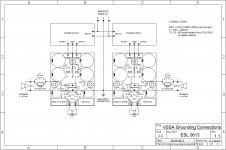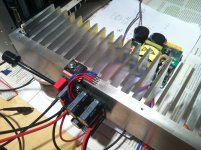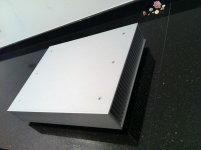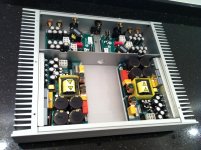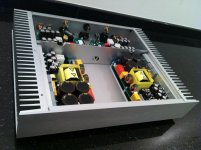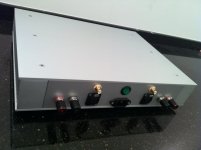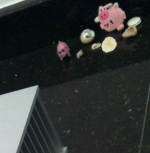Hi Andrej,
Thanks!
I will connect DC sense (L and R) in parallel to Conn. C pin 6 & 8?
Cheers,
Junie
Yes, you can parallel NO contacts (opto coupler output) from DC Sense Protect and connect them to Connector C pin 6, 8. It means that DC error either from left or right channel will turn off power supply and indicate with PROTECT (red LED) that an amp is in protect mode.
My JC-80 is ready to feed the VSSA. Also, my VSSA modules are ready to be mounted, feed and testing. Still need to decide what to use as the power supply... A toroid that is a bit on the small side (250VA) with 4 separate 28V windings, or a bigger one (500VA) with similar 4x 28V windings. It depends also on the internal size of the case.
@LC, can you please post some details?
Cheers!
Definitely use 500 VA toroid since it can feed more current (lower Z) and charge capacitor bank faster. I suggest to use 4 x 4700 uF/50V smoothing capacitors per channel.
If you are planning to buy toroids I would rather suggest you to go on SMPS either Hypex or Connex.
Please follow attached grounding sch.
Attachments
Junie
Have you tried Square 100 khz at full wave p-p with 8Ω load ?
Hi Niko,
I will check later, I'm stuck with the soft start issue.
Junie
Definitely use 500 VA toroid since it can feed more current (lower Z) and charge capacitor bank faster. I suggest to use 4 x 4700 uF/50V smoothing capacitors per channel.
If you are planning to buy toroids I would rather suggest you to go on SMPS either Hypex or Connex.
Please follow attached grounding sch.
Thanks! I have both toroids already. Also I have an SMPS800 that offers only +/-30V and that is too low for 8Ohm speakers. (also only one so that would mean no dual mono build).
My choice also depends on the case you will sell in the group by, to know if they fit or not in the case. Or maybe get another bigger case, don't know yet...
I plan to use 4x15000uF on each channel.
Cheers!
Junie
Have you tried Square 100 khz at full wave p-p with 8Ω load ?
Hi Niko,
I injected 100Khz R21 and R22 start to smoke. I don't want to try it again...not for a long time
Be careful with HF measurements, R21, R22 will soon dissipate more than 0,75 W as they can at best.Hi Niko,
I injected 100Khz R21 and R22 start to smoke. I don't want to try it again...not for a long time
How's the sound in stereo, are you pleased with these tiny amp modules?
Regards LC

Thanks Andrej, R21 and R22 are still in tolerable value but will change it soon.
The first time I fire it up I told myself "I waste my time making VSSA" the sound is "FLAT" no emotion no soul. Then after a few hours of listening, it comes to life. My son told me "Dad close your eyes and fell the music of your new amp ".
".
I'm still breaking it, it's already late my neighbors surely will Bang our main door.
Here the VSSA playing.
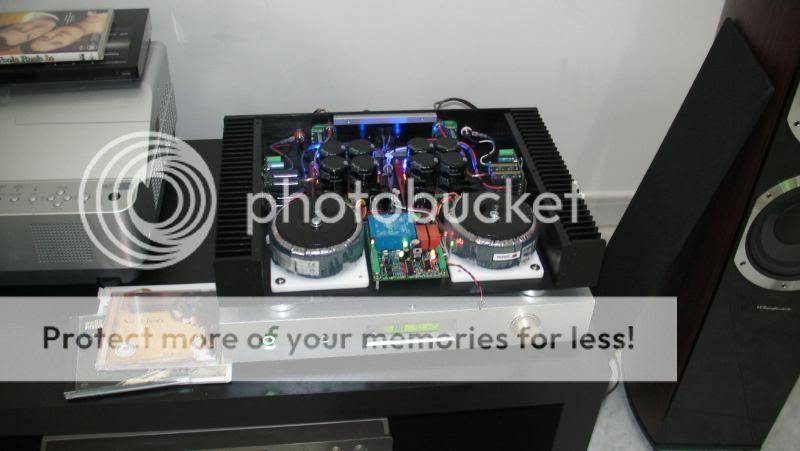
The first time I fire it up I told myself "I waste my time making VSSA" the sound is "FLAT" no emotion no soul. Then after a few hours of listening, it comes to life. My son told me "Dad close your eyes and fell the music of your new amp
I'm still breaking it, it's already late my neighbors surely will Bang our main door.
Here the VSSA playing.

Thanks for brief report. You've made nice power amp for home listening. Capacitors need time to form, to my experiences 30-50 listening hours. As you already know I recommend Nichicon FG series and Vishay and SMPS but that is always personal choice of each DIY-er.
Enjoy in music, many new details will reveal from well known recordings.
Enjoy in music, many new details will reveal from well known recordings.

Today's play, VSSA with extra ALF mosfet added in parallel. 68 Vpp max. meaning 144 Wrms/4 Ohm. 68 Vpp remains the same with or without 4 Ohm load connected, so perfect load regulation (very high damping, low Zout), measured from 10 Hz up. 
What's most important, the sound remains the same as with one ALF

What's most important, the sound remains the same as with one ALF
Attachments
Time for glossy magazine style review. I've powered up a TSSA version on Sunday, so a comparison to VSSA imposes. Normally, I should give it up to 30 hours for break in (or for my ears to break down), but with time I tend to lose auditory memory and forget some impressions. Also I'm getting lazy for the write up.
First, I had a VSSA running. The first amp that those hands of mine ever built! It had an unregulated double mono +-35V, 300VA, 60000uF per channel PSU, a lovely supply from Sonny. No fancy shmancy interconnects or speaker wires. Not even nichicons on the amp modules. Just Panasonic FCs and FRs. I gave it next to 30 hours of listening and that was a wonderful time. On the power up you just can't escape to notice the new quality of punch and bass grip. I have never experienced it on my 89.5dB/W/m (2.83V) sensitive speakers. To set it clear, I'm not an experienced audiophile and I have just tried some 3-4 amps in my system. Mostly japanese integrateds and a Quad 707 being last and the best. In that respect it was already dethroned. You can't unlove those transients that VSSA provides on my quite sluggish 13" woofers, crossed at 600 Hz. Makes you tap the toe. The second best feature of VSSA in regards to my previous amp, was it's ability to communicate the mood of every recording. Now you can go face palming, I can't find more suitable terms. Every record changed, this amp was bringing out different ambience and surroundings. Loved it. And that was with the source that no one would bother to call audiophile. My guess, it is related to the soundstage that is projected so well with this amp. On the longer run, another totally subjective and obscure feature revealed itself. Flirt with the listener… Sometimes it was striking a note or reproducing a passage with such a grace, that I had to turn the head towards the speakers. I didn't find it disturbing. And that goes in pair with great overall transparency. This can have one negative side effect. While giving a little bit more listening, I came over that some records where a tad on a bright side. You know, the ones that gives you listening fatigue very soon. Again, it might be due to my source, DCB1 pre on Z foils, or my unshielded thin silver coated signal wires and interconnects…
On to TSSA. I have it with V1.6 the errata corrected and Zout lowered. Powered with same PSU, this one had a different character and it's own "world view". It might not have some show stopping features like VSSA, but it levels them out on tone and musicality. Very mellow overall, discrete and introvert artist. Smooth operator in short. Paints the world in wider brushes, as Sonny said, and I agree. Salas has previously found an analogy between tones of a phono stage and a tape on Dolby C. I was listening to pro Technics deck a good part of my teenage years and I think I know what it means. TSSA is close to that nice tone, especially noticed on piano and brass instruments. It has a bit more power when turning the knob and runs much hotter. Although, less grip, smoother transients, less stage stand off. You can write this off to disadvantages in comparison, nevertheless TSSA proves very enjoyable to listen. I attribute this to perfect balance. It still fills my big room better with bass than my commercial 130W rated amp. But most importantly it fills room with Music.
It proves to be a tough choice between the 2. And I find myself thinking of bi-amping. But that's an extravagant investment. I have yet to try removing bypass caps on TSSA and, alas, I can't try SMPS with VSSA as I'm not very savvy of changing SMD parts (R19, R20).
Also, as I'm on vacation, I'd love to finally put my scope to use and perform some measurements on these amps. If anyone rembers a good place with basic amp measurement instructions, please share.
First, I had a VSSA running. The first amp that those hands of mine ever built! It had an unregulated double mono +-35V, 300VA, 60000uF per channel PSU, a lovely supply from Sonny. No fancy shmancy interconnects or speaker wires. Not even nichicons on the amp modules. Just Panasonic FCs and FRs. I gave it next to 30 hours of listening and that was a wonderful time. On the power up you just can't escape to notice the new quality of punch and bass grip. I have never experienced it on my 89.5dB/W/m (2.83V) sensitive speakers. To set it clear, I'm not an experienced audiophile and I have just tried some 3-4 amps in my system. Mostly japanese integrateds and a Quad 707 being last and the best. In that respect it was already dethroned. You can't unlove those transients that VSSA provides on my quite sluggish 13" woofers, crossed at 600 Hz. Makes you tap the toe. The second best feature of VSSA in regards to my previous amp, was it's ability to communicate the mood of every recording. Now you can go face palming, I can't find more suitable terms. Every record changed, this amp was bringing out different ambience and surroundings. Loved it. And that was with the source that no one would bother to call audiophile. My guess, it is related to the soundstage that is projected so well with this amp. On the longer run, another totally subjective and obscure feature revealed itself. Flirt with the listener… Sometimes it was striking a note or reproducing a passage with such a grace, that I had to turn the head towards the speakers. I didn't find it disturbing. And that goes in pair with great overall transparency. This can have one negative side effect. While giving a little bit more listening, I came over that some records where a tad on a bright side. You know, the ones that gives you listening fatigue very soon. Again, it might be due to my source, DCB1 pre on Z foils, or my unshielded thin silver coated signal wires and interconnects…
On to TSSA. I have it with V1.6 the errata corrected and Zout lowered. Powered with same PSU, this one had a different character and it's own "world view". It might not have some show stopping features like VSSA, but it levels them out on tone and musicality. Very mellow overall, discrete and introvert artist. Smooth operator in short. Paints the world in wider brushes, as Sonny said, and I agree. Salas has previously found an analogy between tones of a phono stage and a tape on Dolby C. I was listening to pro Technics deck a good part of my teenage years and I think I know what it means. TSSA is close to that nice tone, especially noticed on piano and brass instruments. It has a bit more power when turning the knob and runs much hotter. Although, less grip, smoother transients, less stage stand off. You can write this off to disadvantages in comparison, nevertheless TSSA proves very enjoyable to listen. I attribute this to perfect balance. It still fills my big room better with bass than my commercial 130W rated amp. But most importantly it fills room with Music.
It proves to be a tough choice between the 2. And I find myself thinking of bi-amping. But that's an extravagant investment. I have yet to try removing bypass caps on TSSA and, alas, I can't try SMPS with VSSA as I'm not very savvy of changing SMD parts (R19, R20).
Also, as I'm on vacation, I'd love to finally put my scope to use and perform some measurements on these amps. If anyone rembers a good place with basic amp measurement instructions, please share.
Guess what's next ...


Official VSSA case with half size heatsinks homes SMPS1200/NC1200 combo in dual mono configuration.
Attachments
This plancha is way too big for these tiny lazy pigs
About what is the word, pls explain
- Home
- Vendor's Bazaar
- VSSA Lateral MosFet Amplifier
